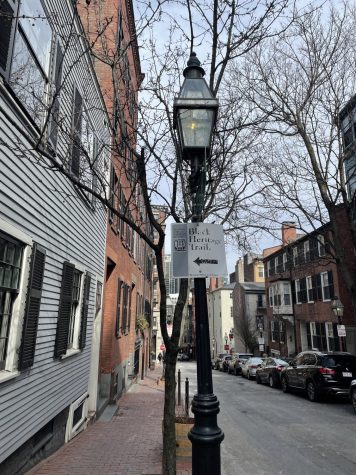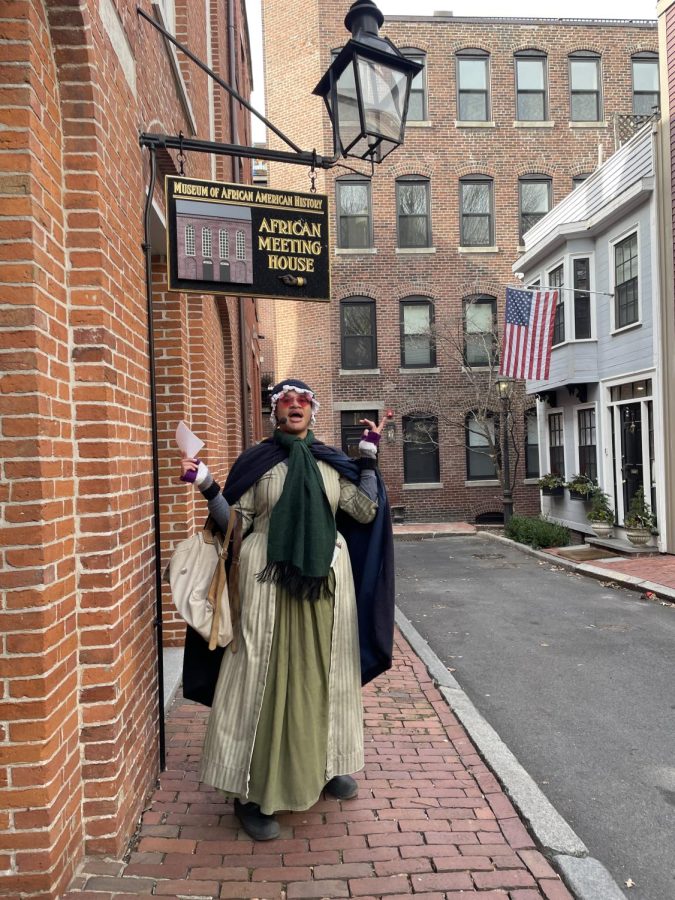Black History Month Freedom Trail tours highlight Black revolutionaries
Tour guide Kelli Strong, dressed as Phylis Wheatley stands in front of the African Meeting House. African American Patriots tours are offered by the Freedom Trail throughout February.
February 24, 2023
During February, the Freedom Trail offers the African-American Patriots tour, featuring the history of African-American revolutionaries to the public.
“I think in all of our tours we are emphasizing sharing stories of all of Boston’s people, especially in Revolutionary history, but we have been emphasizing sharing the stories of traditionally underrepresented people as well, for the past several years,” said Freedom Trail Experiences Officer Catherine Benjamin.
The tour takes attendees through the historic streets of Beacon Hill along the Freedom Trail. Along the way, the tour highlights the stories of members of the African-American community that have gone untold in mainstream historical education.
Tour guide Kelli Strong led the tour dressed as Phillis Wheatley, an 18th-century slave and poet. Strong began the tour by narrating the life story of Phillis Wheatley, who was purchased as a child by John and Susanna Wheatley, but still learned to read and write and became a published poet.
“Not everybody was excited about my poetry, Governor [Thomas] Hutchinson our last royal governor of Massachusetts did not think I was truly the author of this poetry, he thought it was an elaborate hoax to make money,” Strong said in character as Wheatley.
Hutchinson and many others believed an enslaved woman was incapable of such a feat. Wheatley’s naysayers went as far as putting her on trial to prove her authorship.
Later in life, Wheatley’s mistress died and granted her freedom, only for her to marry a man who took any money she had from her publication.
Phillis Wheatley died at the ripe age of 31 years old by the hands of typhus, she said.
“If you guys are expecting happy endings, this is an African American history tour, it’s not gonna go that way,” Strong said.
The African-American Patriots tour begins at the Boston Common, which was a white-only space for much of Boston’s history. The exception to this segregation was Negro Election Day, the third Saturday in July, a day of celebration when a Black governor, a liaison between slaves, colonial leaders and white slave owners was elected.
However, there are no firsthand accounts to get a better sense of the day.
“There’s a limited history scope because of who was writing Black history,” Strong said.
One historical site along this tour is the African Meeting House, which was across the street from the sole Black school in Boston — until 1965 when the Racial Imbalance Act was passed. At this site, Strong told the story of the Roberts Family, who fought for the desegregation of education in the 1849 Roberts v. Boston Massachusetts Supreme Judicial Court Case, a case that would be cited in future fights for integration in schools.

The African-American Patriots tour offers stories that have historically gone untold. Another stop, for instance, was the Robert Gould Shaw and the 54th Regiment Memorial, a sculpture that depicts Colonel Shaw leading one of the first Black regiments of the Civil War. The sculptor, Augustus Saint-Gaudens, initially planned to only feature Shaw on the memorial, but the Shaw family insisted including the army of Black soldiers was more important, Strong said.
Stories like these allow underrepresented communities to see themselves in Boston’s history, which often only highlights white men, Strong said.
“I hope it’s an opportunity for people to see their stories told,” Benjamin said.
At another stop, Strong emphasized the difference in the treatment of slaves based on their location in the United States: There was little prospect of freedom in the South, leading many to flee to Boston. However, this choice came with great risk. If a headhunter caught a runaway slave, they would be returned to slavery.
Further along the Freedom Trail lies the Granary Burying Ground, where many historical figures and individuals lie, nearly all of them white. One historical figure buried at this cemetery is John Hancock, but who lies next to him is out of the ordinary. Frank, John Hancock’s “servant,” is one of just three Black people buried in the Granary Burying Ground. Strong brought attention to the use of the word “servant,” rather than “slave,” although in many cases they were subjected to the same treatment.
Strong also told the story of Mark Codman and his sister, two enslaved individuals, who decided to poison their owner. However, the two were caught, and Mark was hung and his sister was burned at the stake. To send a warning to other Massachusetts slaves, Codman’s body was left hanging, seen and cited by Paul Revere during his well-known Midnight Ride.
Guiding the tour group along the Freedom Trail, Strong detailed the underrepresented, and often unknown stories of Boston’s Black history.
“I want the full story, the real story,” said tour attendee Erica Turner.







